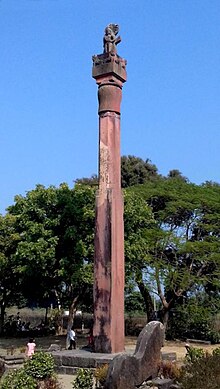This is the current revision of this page, as edited by Garudam (talk | contribs) at 20:43, 12 January 2025 (←Created page with ''''Dhanyaviṣṇu''' was a local leader and vassal under the Huna ruler Toramana, noted in the Eran Stone Boar Inscription from the early 6th century (A.D. 500–515). He was the grandson of Maharaja Indravisnu and the younger sibling of Maharaja Mātṛviṣṇu. He is recognized for continuing the religious and architectural endeavors by his family.{{sfn|Sharma|1978|p=41}} Dhanyaviṣṇu...'). The present address (URL) is a permanent link to this version.
Revision as of 20:43, 12 January 2025 by Garudam (talk | contribs) (←Created page with ''''Dhanyaviṣṇu''' was a local leader and vassal under the Huna ruler Toramana, noted in the Eran Stone Boar Inscription from the early 6th century (A.D. 500–515). He was the grandson of Maharaja Indravisnu and the younger sibling of Maharaja Mātṛviṣṇu. He is recognized for continuing the religious and architectural endeavors by his family.{{sfn|Sharma|1978|p=41}} Dhanyaviṣṇu...')(diff) ← Previous revision | Latest revision (diff) | Newer revision → (diff)Dhanyaviṣṇu was a local leader and vassal under the Huna ruler Toramana, noted in the Eran Stone Boar Inscription from the early 6th century (A.D. 500–515). He was the grandson of Maharaja Indravisnu and the younger sibling of Maharaja Mātṛviṣṇu. He is recognized for continuing the religious and architectural endeavors by his family. Dhanyaviṣṇu is particularly known for finishing a large Varaha statue and managing the building of a temple for Narayana at Eran, which is on the southern side of the River Bina. His survival after the Gupta Empire's fall and his choice to follow Toramana shows a time of political change and the ongoing hope during a period of declining power.
Maharaja| Dhanyaviṣṇu | |
|---|---|
| Maharaja Vishayapati | |
 Eran Ruins with remains of Lion Statue and Vishnu Temple in the background. Eran Ruins with remains of Lion Statue and Vishnu Temple in the background. | |
| Predecessor | Mātṛviṣṇu |
| Religion | Vaishnavism |
| Military career | |
| Battles / wars | First Battle of Eran |
Etymology
Dhanyaviṣṇu, the grandson of King Indravisnu and the younger sibling of King Mātṛviṣṇu, is also noted in Eran Stone Boar In͏scription from time of Toramana (A.D. 500-515). His name shows the custom of using words before names of gods; "Dhanya" means "bringing money or rich".
In the same writing, the word "Sva-visaya" is used to show Dhanyaviṣṇu as a helper of King Toramana maybe being the Vishayapati (area chief) of Eran. The writing shows how power changed when Toramana, after his win in the First Battle of Eran, moved up his title from Rajadhiraja (as seen in the Khura Stone Writing) to Maharajadhiraja (like in the Eran stone Boar Writing), which was a name once saved for Gupta kings.
Historical significance

Dhanyaviṣṇu survived the turbulent events and was left with a decision to either accept the rule of the new emperor, the Alkhan king, or die. He chose to survive and took up the new sovereignty. Despite the fall of the Gupta Empire, hope prevailed, symbolized by the gigantic 3.5-meter-high Varaha image that Dhanyaviṣṇu completed. This statue was a testament to his faith, evoking the Mahabharata's description of the god who "lifted the earth on his tusk" in a time of cosmic despair.
Legacy

The inscription also marks the continuation of a project begun under emperor Budhagupta by his local feudatory Mātṛviṣṇu and his brother Dhanyaviṣṇu. This project included the construction of a religious complex dedicated to Viṣṇu, the tutelary deity of the Gupta Empire, on the southern banks of the River Bina. In addition, Toramana issued coins bearing the symbol of the Sun and granted Dhanyaviṣṇu permission to build a temple dedicated to Narayana in Eran, further solidifying his loyalty to the newly established order.
See also
References
Citations
- ^ Sharma 1978, p. 41.
- Sharma 1978, p. 220-221.
- ^ Balogh 2020, p. 330.
- Bakker 2020, p. 76.
- Fleet 1960, p. 88.
- Bajpai, K. D. (2004). Indian Numismatic Studies. Abhinav Publications. pp. 19–20. ISBN 978-81-7017-035-8.
- Goyal 1967, p. 345.
Sources
- Sharma, Tej Ram (1978). Personal and Geographical Names in the Gupta Inscriptions. Concept Publishing Company. p. 41.
- Bakker, Hans T. (2020-03-12). The Alkhan: A Hunnic People in South Asia. Barkhuis. p. 33. ISBN 978-94-93194-00-7.
- Goyal, S. R. (1967). A history of the Imperial Guptas. With a Foreword by R. C. Majumdar.
- Balogh, Dániel (2020-03-12). Hunnic Peoples in Central and South Asia: Sources for their Origin and History. Barkhuis. ISBN 978-94-93194-01-4.
- Fleet, John F. (1960) . Inscriptions Of The Early Gupta Kings And Their Successors. Inscriptionum Indicarum. Vol. III (3rd Revised ed.). Varanasi, India: Indological Book House.